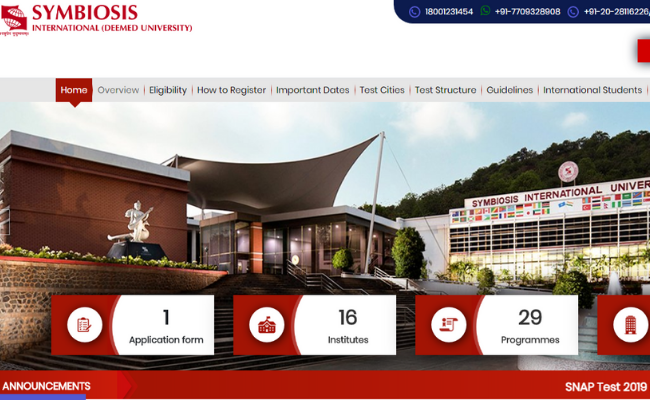The SNAP entrance examination is conducted every year for the selection of eminent candidates for MBA/PGDM programmes offered by several institutions associated with the Symbiosis International University (SIU).
The online computer-based test is conducted for hundreds of aspirants from different corners of the country. The candidates planning to give the SNAP test must be aware of the syllabus, exam pattern and other necessary details.
The SNAP exam comprises of 115 questions based on 4 distinct sections, namely, English Grammar and reading comprehension section, Analytical and Logical reasoning section, Quantitative aptitude and Data Interpretation section and current affairs.
The time duration for the test is of 2 hours. The marking scheme for questions is based on the sectional division and the number of questions in each section. Out of 115 questions, 110 questions are of objective type, whereas 5 questions are of a non-objective type.
To summarise the details regarding the test pattern and composition of questions per section are given below.
| Section | Section Topic | Objective questions (MCQs) | Non-objective questions (non-MCQs) |
|
|
English Grammar and reading comprehension | 30 | 0 |
|
|
Quantitative Aptitude and Data interpretation | 30 | 5 |
|
|
Analytical and Logical Reasoning | 30 | 0 |
|
|
Current Affairs | 20 | 0 |
| Total Questions | 115 | 110 | 5 |
| Total Time duration | 120 minutes (2 hours) |
SNAP 2020 Syllabus
While preparing for the SNAP 2020 test, knowledge of vast topics and subjects is necessary. To score good scores and high ranks, the candidates must learn and prepare every topic in the syllabus list.
This would ensure that strategical preparation for the final exam. Since the exam paper comprises of four distinct sections, therefore, the candidates must prepare as per the test format and pattern. The syllabus topics for each section are mentioned herewith.
| Section | Section Name | Topics/Subjects |
|
|
English Grammar and reading comprehension | Reading Comprehensions
Idioms Sentence arrangement Sentence correction Sentence completion Antonyms and Synonyms Manias and Phobias Figure of speech One-word substitution Jumble sentences Word meanings Odd one out Vocabulary Contextual usage Fill in the blanks Active voice and passive voice |
| 2 | Quantitative Aptitude and Data interpretation | Complex numbers
Integers Ratio and proportion Time and work Distance Averages Percentage Profit and loss Interest Number system Fractions LCM and HCF Complex numbers Speed and time Probability Arithmetic mean Geometry Trigonometry Mensuration Congruency Sets and functions Permutation and combination Inequalities Progressions Logarithm Surds and indices Tables Series Bar graphs Co-ordinate geometry Binomial theorem Graphs pie charts Linear equation and quadratic equation Algebra |
| 3 | Analytical and Logical Reasoning | Relation-based questions
Assertion and reasons Statement Assumptions Types of arguments Cause and effect Inference and judgement Critical thinking and reasoning Statement based on true and false Family tree- blood relations Seating arrangement Clocks and calendars Direction sense Syllogisms Visual reasoning Coding and decoding Matrix Analogy and series Mathematical reasoning Verbal and miscellaneous |
| 4 | Current Affairs | General knowledge
National news International news Science and technology Economy Corporate affairs Personalities |
The above-mentioned question must be prepared thoroughly before the exam date. However, the QA & DI and analytical reasoning sections are considered to be the toughest. The candidates opt for several mock test series and practise paper before the final examination.
For current affair section, the candidates must keep a check on the latest news, updates in the world of science, technology, economy, corporate and others. Moreover, reading newspaper headlines could be a great option too.
However, the QA & DI sections hold maximum weightage. 30 objective-type question and 5 special non-objective type questions are asked in the SNAP 2020 paper. Therefore, the aspirants must prepare themselves for some of the trickiest questions of all times.
The aspirants must also polish their time management skills by practices several mock tests and practise paper before the final exam date.
Being updated with the test format and syllabus will assist the candidates in developing strategies for scoring high marks. Hence, the aspirants must prepare themselves accordingly and should not miss any of the topics mentioned in the syllabus.
About SNAP 2020
As per the latest update released by the authorities, SNAP 2020 is planned to be conducted in the second week of December 2020. It is one of the most well-known MBA entrance tests conducted for hundreds of young professionals.
The online computer-based test is designed to test the critical. Logical and technical thinking abilities of future leaders. The scores achieved in the entrance test are accepted by several recognised b-schools of the country.
The authorities have also made certain changes in the test format and pattern. Therefore, the aspirants must be well-aware of every detail before applying for the test.
Stay connected with fellow students on PaGaLGuY for CAT Exam 2020 Discussion
Stay connected with fellow students on PaGaLGuY for [Official] SNAP 2020 Exam Discussion
